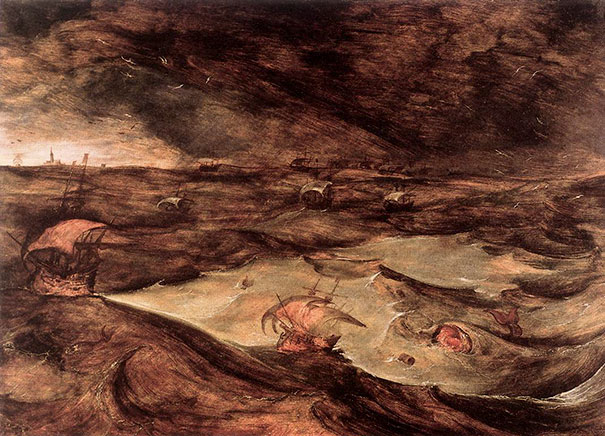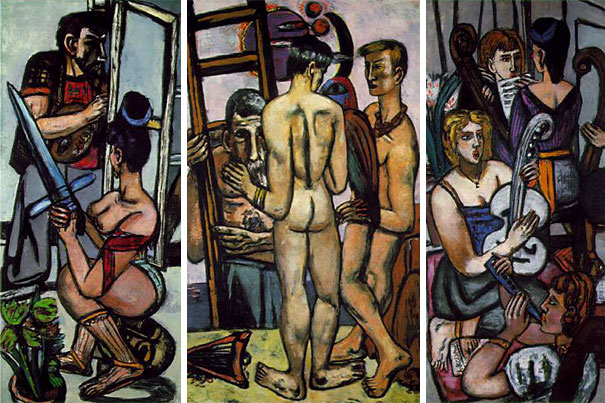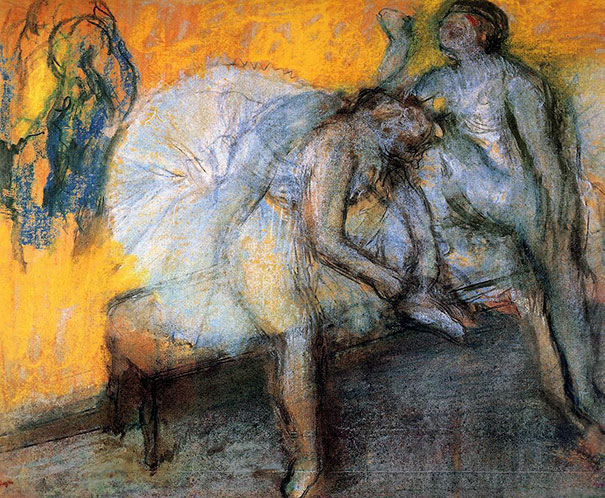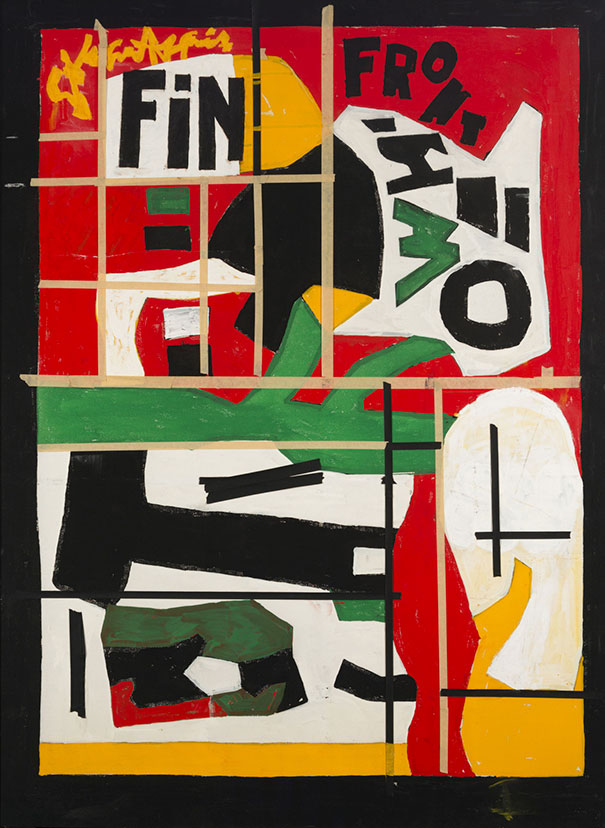Have you ever wondered what the last artworks of some of history's famous artists looked like? Well, if so, then you’re in luck because we've collected thirty-seven final masterpieces from some of the world’s most well-known artists.
Compiled by Bored Panda, the list includes work from contemporary artists like Picasso and Matisse to classical masters including Caravaggio and Rafael. Scroll down to find your favorite artist, and don't forget to vote.
This post may include affiliate links.
Claude Monet: Water Lilies Murals (1926)
The Grandes Décorations (1920/26) are a collection or murals that comprise Claude Monet's last works. They depict his beloved water lilies and he painted them when both his eyesight and health were failing. As his sight worsened due to cataracts, his works turned from fresh, bright colours to blurred visions of heavy browns and reds. He wrote letters to friends, how colors were getting dull, and it was hard to tell them apart, and how he had to label tubes of paint. Monet specified that when he died he wanted to be buried like "a local man," adding "“Above all, remember I want neither flowers nor wreaths. Those are vain honors. It would be a sacrilege to plunder the flowers of my garden for an occasion such as this.” (source: monetartprints, livescience)
Monet had cataracts. The oranges and blues of his paintings become almost indistinguishable. His vision got cloudy late in life, and his whole world blurred like, well, like a Monet. He wrote letters to friends, how colors were getting dull, and it was hard to tell them apart, and how he had to label tubes of paint,
Keith Haring: Unfinished Painting (1990)
Keith Allen Haring was an American artist and social activist whose work expressed concepts of birth, death, sexuality, and war. His work was often political, and his style is highly distinctive. One of his last works was finished shortly before the artist died from AIDS-related complications in 1990. The painting serves as a poignant statement about a life cut short at the age of thirty-one. (source: es.npg.si.edu)
Pablo Picasso's Last Self-Portrait (1972)
Picasso's last well-known self portrait is called, somewhat aptly, Self Portrait Facing Death. He drew it with crayon on paper in 1972, less than a year before his death. Picasso worked right up until the day he died, aged 91, painting until 3am on Sunday, April 8th, just hours before he passed away. (source: arts.pallimed.org)
A friend of Picasso's , Pierre Daix,said on a visit to Picasso, "Picasso held the drawing beside his face to show that the expression of fear was a contrivance." Then on another visit 3 months later, Pierre recalled that the harsh colored lines were even deeper, and Pierre writes, "He did not blink. I had the sudden impression that he was staring his own death in the face"
Vincent Van Gogh: Tree Roots (1890)
Wheatfield With Crows (1890) is often considered to be Vincent van Gogh's last work, perhaps because the ominous setting was in fact the place he chose in real life for his final, successful suicide attempt. It is however more likely that his final work was Tree Roots, painted in Auvers-sur-Oise, France, shortly after he left an asylum in Saint-Rémy. (source: vangoghmuseum.nl)
Interesting to note that Van Gogh had already made several drawings of tree roots in The Hague almost ten years earlier. At that time he stated of his wish ‘to express something of his life’s struggle in those gnarled black roots’. The same symbolism is seen in these twisted tree roots, painted eight years later.
Jean-Michel Basquiat: Riding With Death (1988)
Whether or not Riding With Death (1988) is Jean-Michel Basquiat’s final painting is still up for debate. The work certainly has a morbid quality about it that evokes a sense of an ending, and Basquiat painted it shortly before his own death from a heroin overdose in 1988. (source: Jean-Michel Basquiat: 1960-1988)
Salvador Dali: The Swallow's Tail (1983)
Salvador Dali completed his last painting in the spring of 1983. The work is titled Swallows Tail and is the last in a series of paintings he did based on Catastrophe Theory, originated by the French mathematician Rene Thom in the 1960s. Catastrophe theory is a brand of mathematics that studies how small changes in circumstances can lead to sudden shifts in behavior. The painting was Dali's attempt to represent his understanding of this mathematical theory. Salvador Dali died in 1989, aged 84. (source: wikiart.org)
Frida Kahlo: Viva La Vida, Watermelons (1954)
VIVA LA VIDA is Mexican artist Frida Kahlo's last work. She completed it eight days before she died on July 13, 1954, aged 47. The painting is a still life with watermelons, a fruit that is a popular symbol in the Mexican day of the dead (Dia de los Muertos). Watermelons are also a frequent feature in Mexican art. Viva La Vida means "long live life" in Spanish. (source: artanddesigninspiration.com)
Edouard Manet: A Bar At The Folies-Bergère (1882)
Édouard Manet (1832 – 1883) was a French painter. He was one of the first 19th-century artists to paint modern life, and a central figure in the transition from Realism to Impressionism. His last painting was A Bar at the Folies-Bergère (Un bar aux Folies Bergère), which was completed in 1882, just a year before he died after having his foot amputated due to gangrene. It originally belonged to the composer Emmanuel Chabrier, who was Manet's neighbor, and hung over his piano. (source: wikipedia.org)
Gustav Klimt: The Bride (1918)
Gustav Klimt never finished his last painting, titled The Bride (1917/1918), but this uncompleted work gives us a fascinating insight into the artist's technique as well as his inner desires. The painting depicts naked women, because Klimt died before he could dress them, but the fact that he first painted his subjects naked before dressing them in clothes reveals the sexual obsession that lay beneath the surface of Klimt's works. (source: gustav-klimt.com)
Francis Bacon: Study Of A Bull (1991)
Study of a Bull was completed in 1991 just months before the artist, Francis Bacon, died as a result of chronic asthma. Having spent its life in a very private collection in London, the painting has never been seen publicly. It was discovered when an art historian named Martin Harrison was researching Bacon's work for the publication of the Francis Bacon Catalogue Raisonné. Harrison maintains that Bacon knew that he was close to death when he was working on this particular piece. “Bacon is ready to sign off … he was so ill… He knew exactly what he was doing here," he said.
(source: francis-bacon.com)
Rembrandt: Simeon With The Christ Child In The Temple, Unfinished (1669)
This painting by Rembrandt van Rijn (1606-1669) was found uncompleted in his studio prior to his sudden death aged 63. It now hangs in the National Museum in Stockholm, Sweden. The painting depicts an old man holding an infant, a subject he had painted twice before. The work illustrates a passage from the Gospel of St. Luke, in which Mary and Joseph take Jesus to the temple in Jerusalem. The figure in the background was probably painted afterwards by somebody else. Some people think she's Maria, while others say she's the prophetess Anna. (source: artbible.info)
Georgia O'Keeffe: The Beyond, Last Unassisted Oil Painting (1972)
Georgia Totto O'Keeffe was an American artist. She was known for her paintings of New York skyscrapers, enlarged flowers, and New Mexico landscapes. O'Keeffe is often regarded as the "Mother of American modernism." Her eyesight was compromised by macular degeneration in 1972, and this left her with only peripheral vision. This naturally affected her work and she stopped oiling painting without assistance in 1972, although she continued with help thereafter. Her last unassisted oil painting is called The Beyond (1972). (source: Georgia O'Keeffe, a Private Friendship: Walking the Abiquiu and Ghost Ranch land)
Marcel Duchamp: Étant Donnés (1966)
Henri-Robert-Marcel Duchamp (1887 – 1968) was a French, naturalized American painter, sculptor, chess player and writer whose work is associated with Cubism and conceptual art. Along with Pablo Picasso and Henri Matisse, Duchamp is generally considered as one of the three artists who helped to define the revolutionary developments in the plastic arts in the opening decades of the twentieth century. His last major work was Étant donnés (1966), which surprised most of the art world who believed he had given up art for competitive chess almost 25 years earlier. He died two years later, suddenly and peacefully, at his home in Neuilly-sur-Seine, France. (source: wikipedia.org)
Nice Interesting post Thanks for sharing. visit my blog about famous painting. https://www.overstockart.com/
Henri Matisse: La Gerbe, One Of His Last Works (1953)
French artist Henri Matisse (1869-1954) was a revolutionary and influential painter of the early 20th century, best known for the expressive color and form of his Fauvist style. His last work was Le Gerbe (1953), a piece made from ceramic tile embedded in plaster. It was his only west coast commission and it can be found in the Los Angeles County Museum of Art (LACMA). (source: lacma.org)
Lucky the people who have this piece hanging in their living room. I LOVE this.
Raphael: The Transfiguration (1520)
Raffaello Sanzio da Urbino (1483 – April 6, 1520) known as Raphael, was an Italian painter and architect of the High Renaissance. Together with Michelangelo and Leonardo da Vinci, he forms the traditional trinity of great masters of that period. His last work was The Transfiguration (1520). It was commissioned by Cardinal Giulio de Medici, the later Pope Clement VII (1523–1534), and it can now be found in the Pinacoteca Vaticana in Vatican City. (source: wikipedia.org)
Rene Magritte: The Empire Of Lights, Unfinished (1967)
René François Ghislain Magritte was a Belgian surrealist artist. He is best known for his witty and thought-provoking images. The artist continued to work until the year of his death in 1967, and his final unfinished piece is called The Empire of Lights. The painting had been commissioned by a German collector from Cologne, but he never received the picture, because it remained on the easel of the painter's house in Brussels until the death of his wife Georgette in 1986. (source: mattesonart.com)
Pieter Bruegel The Elder: Storm At Sea, Unfinished (1569)
Pieter Bruegel the Elder (1525-1569) was a Netherlandish Renaissance painter and printmaker known for his peasant scenes and landscapes. His last work was Storm at Sea, an unfinished oil-on-panel painting depicting ships in the midst of choppy waters. It can be found in the Kunsthistorisches Museum in Vienna. (source: Brittannica.com)
Paul Cézanne: The Gardener Vallier (1906)
Paul Cézanne (1839-1906) was a French artist and Post-Impressionist painter. Between 1902 and 1906, Cézanne painted a number of portraits of Vallier, the gardener at his Les Lauves studio. The one he painted in 1906, which is comparable with the late portraits of Rembrandt, both in its seriousness of mood and in its bold, broad execution, is thought to be his last work. (source: nga.gov)
Caravaggio: Martyrdom Of Saint Ursula (1610)
Michelangelo Merisi (Michael Angelo Merigi or Amerighi) da Caravaggio (1571 – 1610) was an Italian painter. His work is characterised by a dramatic use of lighting, and he is thought to have had a formative influence on Baroque painting. His last work is thought to be The Martyrdom of Saint Ursula. It is now a part of the Intesa Sanpaolo Collection in the Gallery of Palazzo Zevallos Stigliano, Naples. Caravaggio died in 1610 while on his way to receive a pardon from the Pope for his part in the death of a young man in a duel four years earlier. The circumstances surround his death are unclear, but a fever is the most frequently cited cause. (source: wikipedia.org)
Paolo Uccello: Hunt In The Forest (1470)
Paolo Uccello (1397 – 10 December 1475), born Paolo di Dono, was an Italian painter and a mathematician who was known for his work on visual perspective in art. His best known works are the three paintings representing the battle of San Romano. His final painting was The Hunt in the Forest (1470). It demonstrates the use of perspective in Renaissance art, with the hunt participants disappearing into the dark forest in the distance. It is perhaps the best-known painting in the Ashmolean Museum in Oxford, England. (wikipedia.org)
Hieronymus Bosch: Christ Carrying The Cross (1535)
Hieronymus Bosch (1450-1516) was well known for his hellish imagery, and his last work is no exception. Titled Christ Carrying the Cross (1490), the painting is "a harsh indictment of human evil. Nineteen heads are crushed tightly together. Most are nightmarish images, contorted and beastlike. Besides Jesus, only the good thief and Saint Veronica retain human features. Their passive expressions separate them from the hate that rages around them." (source: Renaissance and Reformation, Volume 1)
Max Beckmann: The Argonauts (1950)
German artist Max Bechmann's last work is actually a triptych titled "The Argonauts" (1949-1950). The paintings are a play on a Greek myth that had interested him since he exiled himself to Amsterdam during World War 2. The Argonauts were a band of heroes who, in the years before the Trojan war, traveled with Jason to Colchis in his quest to find the Golden Fleece. Beckmann died suddenly in New York in 1950. (source: the economist)
Edgar Degas: Two Dancers Resting I
Edgar Degas was a French artist known for his paintings, sculptures, drawings and prints. He is often associated with the subject of dance, and more than half of his works depict dancers in some form or another. Two Dancers Resting I is thought to be his final pastel painting, which he created at a time when his eyesight had almost completely gone. His vision began to decline when he was 36, and he had lost his central vision by his forties due to a form of retinopathy. The artist died in 1917, aged 83. (source: pastelnews.com)
Georges Seurat: The Circus (1891)
Georges-Pierre Seurat (1859-1891) was a French post-Impressionist painter. He is best known for devising the painting techniques known as chromoluminarism and pointillism. The Circus was his last painting. It's an oil on canvas painted in a Neo-Impressionist style in 1890-91, and it remained unfinished at the time of his death. It can be found at the Musée d'Orsay in Paris. (source: wikipedia.org)
Mark Rothko: Untitled (1970)
Mark Rothko was an American painter of Russian Jewish descent. Although he refused to adhere to any art movement, Rothko is generally identified as an abstract expressionist. He painted a number of gloomy works in the period running up to his death, but his final piece was bright red. He painted it just before his suicide in 1970, when the artist was 66, and the bright red is often considered to be symbolic of the fact that Rothko was found in a pool of blood after cutting his wrists in his New York studio. (spectator.co.uk)
Andy Warhol: Last Supper (1986)
Andy Warhol (1928-1987) was an American artist and leading figure in the visual art movement known as pop art. His work explores the relationship between celebrity culture, artistic expression, and advertising. His final series of paintings, called "The Last Supper," was made in late 1986 and can now be seen at the Guggenheim Museum SoHo. The series was a commission, and the idea was thought up by the late Paris dealer, Alexander Iolas, who arranged for the work to be paid for by the Milan bank Credito-Valtellinese. The pictures were hung in the bank's new premises, just across the street from the Church of Santa Maria della Grazie, where Leonardo da Vinci's noble, dilapidated original can be seen. Warhol, as he often did, used commercial reproductions as his source material. (source: artnet.com)
Stanley Spencer: Christ Preaching At The Cookham Regatta, Unfinished (1959)
Sir Stanley Spencer (1891 – 1959) was an English painter. He became well known for his paintings depicting Biblical scenes as if taking place in Cookham, the small village beside the River Thames where he was born and spent much of his life. Spencer died of Cancer in 1959, and his last work, titled Christ Preaching at Cookham Regatta, remains unfinished. (source: wikipedia.org)
Titian: Pieta (1576)
Tiziano Vecelli, or Tiziano Vecellio, known in English as Titian, was an Italian painter born in 1490. He is thought to be one of the most versatile of Italian painters and was equally adept with landscapes, portraits, and mythological and relgious subjects. Titan died of a fever when the plague hit Venice in 1576. His last work was Pieta, a dramatic, nocturnal scene of suffering. (source: wikipedia.org)
Jackson Pollock: Red Black And Silver By (1956)
Paul Jackson Pollock, otherwise known as Jackson Pollock, was an American painter and a major player in the abstract expressionist movement. He was best known for his unique style of drip painting. His final work was called Red Black and Silver and was painted just months before the artist died in a car accident in 1956. The painting was for his mistress, Ruth Kligman, but because Pollock's wide, Lee Krasner (who naturally hated Kligman) ran the group that authenticated Pollock's work, Red Black and Silver was never declared a true Pollock until CSI tests proved its authenticity in 2013. (source: nypost.com)
Bartolome Esteban Murillo: The Mystic Marriage Of Saint Catherine (1682)
Bartolomé Esteban Murillo was a Spanish Baroque painter. He was born in Seville, Spain, in 1617, and he died in April 1682. He is best known for his religious work but Murillo also produced many paintings of contemporary women and children. His last work is The Mystic Marriage of Saint Catherine (c. 1682), for the altar of the church of Santa Cataline in Cádiz. According to his biographers however, It wasn't actually completed by his hand. The artist fell from scaffolding during the project and died several months later, presumably from his injuries, and so it was up to others to complete his final masterpiece. (source: artdaily.com)
Albrecht Dürer: The Four Apostles (1526)
Albrecht Dürer was a painter and printmaker of the German Renaissance. Born in Nuremberg, Dürer established his reputation and influence across Europe when he was still in his twenties, due to his woodcut prints. He once said that "If a man devotes himself to art, much evil is avoided that happens otherwise if one is idle." His last work was a panel painting titled The Four Apostles. The painting was obtained by the Bavarian Elector Maximilian I in 1627. Since then, the painting has been in Munich and, despite all the efforts of Nuremberg since 1806, it has not been returned. (source: wikipedia.org)
Stuart Davis: Fin (1964)
Stuart Davis was an American modernist painter. He was best known for his jazz-influenced pop art paintings of the 1940s and 1950s. Davis spent a lot of his life suffering from heart problems and high blood pressure. On June 23, 1964, after watching a French movie on TV that concluded with the word “fin” (which means “the end,” in French), he added the word on the painting on his easel before going to bed. He suffered a stroke that very same night and died in the ambulance while en route to New York’s Roosevelt Hospital. (source: whitney.org)
Diego Rivera: The Watermelons (1957)
Diego María de la Concepción Juan Nepomuceno Estanislao de la Rivera y Barrientos Acosta y Rodríguez, known as Diego Rivera, was a prominent Mexican painter. His large frescoes helped establish the Mexican Mural Movement in Mexican art. His last work is an oil on canvas painting called The Watermelons (1957). It was made after Dolores Olmedo, one of his greatest supporters and patrons, asked him to paint it for her. At first he refused, saying that he did not like to paint watermelons. Only when Olmedo said that she would commission another prominent artist to paint them for her did Diego comply. This was the last painting he ever completed and signed. He died in Mexico City shortly after, aged 70. (source: high.org)
Just occured to me that it is interesting that watermelons is his last painting as well as the last painting of Frida Kahlo.
Piet Mondriaan: Victory Boogie Woogie (1944)
Pieter Cornelis "Piet" Mondriaan (after 1906 Mondrian), was a Dutch painter and contributor to the De Stijl art movement, which was founded by Theo van Doesburg. He evolved a non-representational form which he termed neoplasticism. This consisted of white ground, upon which he painted a grid of vertical and horizontal black lines and the three primary colors. He died of pneumonia in 1944. Victory Boogie Woogie is his last, unfinished work, and it has been in the collection of the Gemeentemuseum in The Hague since 1998. It was purchased at a cost of 80 million guilders (approximately 35 million euros) from the American collector Samuel Irving Newhouse. (source: wikipedia.org)
Cy Twombly: Untitled (2011)
Edwin Parker "Cy" Twombly, Jr (1928-2011) was an American painter, sculptor and photographer. His last works were a series of eight untitled paintings using bold, intense colors and a style that was typical of the freedom with which the artist worked. (source: gagosian.com)
Thomas Eakins: Portrait Of Dr. Edward Anthony Spitzka (1913)
Thomas Cowperthwait Eakins (1844 - 1916) was an American realist painter, photographer, and sculptor. He is widely considered to be one of the most important artists in American art history. His last painting was a portrait of Dr. Edward Anthony Spitzka, painted in 1913. It can be found in the Hirshhorn Museum and Sculpture Garden in Washington D.C. (source: thomaseakins.org)
Paul Klee's Untitled Painting (1940)
Paul Klee (1879 – 1940) was a Swiss-German artist. His style was influenced by movements in art that included Expressionism, Cubism, and Surrealism. Klee suffered from scleroderma (a wasting disease) toward the end of his life, and the pain he endured can be seen in his latter works. His final painting was a still life, completed in 1940. The painting was among those left in the artist’s Bern studio in Kistlerweg after his death. His son, Felix, retrospectively called it Das letzte Stilleben (The Last Still Life), a description which has become its title. (source: artistsandart.com)
What a WONDERFUL compilation - thank you Bored Panda. With all the "dark art" being posted lately, I found this more refreshing and uplifting.
Thank you Yvonne for your wonderful comments and additional information!
Load More Replies...As a budding artist, i really just want to stare and interpret their works , every brush stroke or not feels connected.
What a WONDERFUL compilation - thank you Bored Panda. With all the "dark art" being posted lately, I found this more refreshing and uplifting.
Thank you Yvonne for your wonderful comments and additional information!
Load More Replies...As a budding artist, i really just want to stare and interpret their works , every brush stroke or not feels connected.

 Dark Mode
Dark Mode 

 No fees, cancel anytime
No fees, cancel anytime 


















































































































